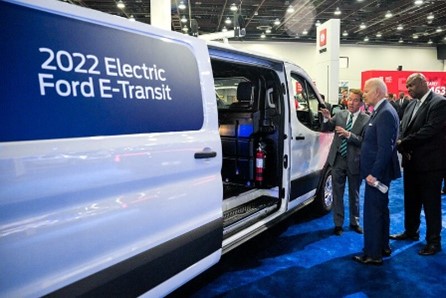
President Joe Biden views the electric Ford E-Transit Van with Ford Exec. Chair Bill Ford and UAW President Ray Curry, right, as he tours the North American International Auto Show.
Biden’s Electric Vehicle Ambitions Hitting Major Roadblocks
By Neil Banerji – September 18, 2023
Biden Secretary of Energy Jennifer Granholm’s recent glitch-filled “electric vehicle road trip” is quickly becoming a metaphor for the White House’s failed EV agenda. Instead of convincing more people to adopt EVs as their primary mode of transportation, the White House seems to have made the inherent shortcomings of EVs more obvious, even as energy industry experts are increasingly warning that the added pull from potentially millions more EV chargers could overwhelm the grid.
Earlier this summer, Granholm set off on a four-day trip across the Southeast in an EV caravan to draw attention to the billions of dollars the White House was pouring into EV subsidies.
But as an NPR article published last week revealed, Granholm’s team was forced to “grapple with the limitations of” existing EV infrastructure. That included members of the secretary’s team – in gas-powered cars – driving ahead to block off chargers for the EV caravan.
In one instance, as Granholm was traveling through Grovetown, a suburb of Atlanta, a staffer parked a gas-powered car in front of one of just three working chargers at a local charging station. The act created a minor crisis as “a family that was boxed out — on a sweltering day, with a baby in the vehicle — was so upset they decided to get the authorities involved: They called the police.”
Unsurprisingly, left-leaning NPR concluded that the solution to the problem was just more chargers. But that brings with it a whole host of other, potentially even more serious issues.
The Biden administration has called for two-thirds of all new light vehicle sales to be electric by 2032. EVs made up just 3 percent of new vehicle sales in 2021, meaning that Biden’s goal would necessitate a complete overhaul by every major automaker.
But with energy demand already expected to sky-rocket 18 percent by 2030 and 38 percent by 2035, the grid may not be able to handle millions more EV chargers. A report released in April from NERC, a nonprofit whose mission is “to assure the effective and efficient reduction of risks to the reliability and security of the grid,” has warned that mass EV adoption could lead to unplanned blackouts throughout the country. With no power, EV owners will then be effectively trapped in their homes.
As the report explains, most traditional household electricity uses like heating, lighting, and cooking appliances, are considered “grid-friendly” because “as voltage drops slightly, the device power draw also reduces and hence supports stable steady-state operation of the grid.”
But EV chargers work differently. They instead seek “to maintain either a constant current level or a constant power level regardless of system voltage or frequency.” As a result, this constant power load “exacerbates system instability because, during events on the system when voltage reduces, the load draws more current in order to maintain constant power.”
This problem is likely to become even worse amid Biden’s push for more renewable energy production. Currently, about 79 percent of the country’s energy comes from fossil fuels. Biden has set a goal of 80 percent of US energy production to be renewable by 2030 and for the country to be 100 percent renewable by 2035 – targets that experts have said are completely unrealistic.
Yet even as adoption of renewables lags, Biden has continued to wage an all-out war on the fossil fuels industry. Earlier this month, Biden canceled previously-issued drilling leases in Alaska. Biden has also pledged to shut down coal plants “all across America” and has buried fossil fuels companies in a mountain of new emissions regulations.
These moves are likely to cause the price of electricity (and gas, for that matter) to increase in the months ahead, creating another headache for drivers.
With the 2024 elections now just over a year away, it’s worth considering how Biden’s failed EV push and parallel effort to snuff out fossil fuels might influence voters’ decisions.
While Democrats’ famous 2010 midterm “shellacking” is widely recognized as a backlash against Obamacare, many Democrats also faced a reckoning over their support for a “cap-and-tax” bill on greenhouse emissions. Americans are already paying an average of $2,800 more per year in energy costs under Biden. Further increases could make for a bad night for Democrats.
Incumbent Democrat Senators Joe Manchin, Sherrod Brown, and Jon Tester of West Virginia, Ohio, and Montana, respectively, all of whom face re-election next year, could be in for particularly rough campaigns. All of these states already lean Republican and have a significant economic interest in fossil fuels. If Republicans can tie these Democrats to Biden’s policies, they will be well on their way to flipping those seats red.
Biden’s presidency has seen no shortage of radical, ill-formed policies. But his energy agenda and obsession with electric vehicles may prove to be one of the most damaging of them all – both for the country and his re-election bid.
Neil Banerji is a proud Las Vegas resident and former student at the University of Oxford. In his spare time, he enjoys reading Winston Churchill and Edmund Burke.
